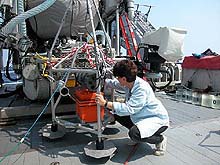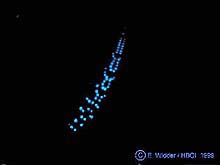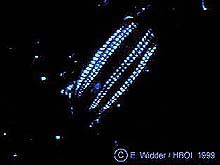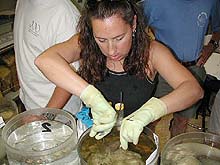Plan B
August 23, 2002
Edie Widder, Ph.D., Senior Scientist Bioluminescence Department Harbor Branch Oceanographic Institution
I am sitting on a bucket of Sodasorb with my laptop balanced on a tool box and the guts of the Eye-in-the-Sea laid out on a too-short workbench beside me. The down-side computer is running ScanDisk. It’s been doing this for an hour and a half and it looks like it’s got another two and a half hours to go. I’m pretty sure this is not normal, but I’m running out of ideas and at least it gives me the illusion of doing something useful. During the course of the day I have tried numerous ways to convince the computer that this compulsive disk checking is not necessary but Windows thinks it knows better.

Dr. Edie Widder double-checks her Eye-in-the-Sea camera before it is deployed by the Johnson-Sea-Link-II. Click image for a larger view.
From the outset Eye-in-the-Sea has been a labor of love, mixed with a large measure of frustration. It was 1994 when I first tried – unsuccessfully - to get funding to develop this deep-sea observatory system. With funding dollars so limited, such highly exploratory projects are often difficult to finance. Therefore, what many investigators do is carry out enough work in advance to be able to convince the funding agency that they have a workable plan. Two years ago I got an opportunity to lay the ground work for Eye-in-the-Sea when my home institution, Harbor Branch Oceanographic Institution, generously put up $35,000 to fund the Harvey Mudd Engineering Clinic to develop a bench-top version of my concept as a student project. Since then, a lot of different ingredients have gone into the mix including $15,000 from NOAA’s Office of Ocean Exploration to put the system in an underwater housing, ship and remotely-operated vehicle (ROV) time from the Monterey Bay Aquarium Research Institute for a first test deployment and lots more engineering, some of it donated by friends and some of it paid for with the sale of images and video of bioluminescence.

Bioluminescence emitted from the ventral surface, or underside, of a deep sea fish belonging to the Family Myctophidae. Click image for a larger view.
Instrument development is challenging under the best of circumstances, but when you throw in 3,000 feet of sea water, a rolling ship and tapped out finances, Murphy’s Law soon becomes an insurmountable force of nature. The good news it that the deployment and eventual recovery by the JSL went well. Even better, while it was on the bottom the camera took pictures – its first. It was programmed for timed and triggered mode and it did fine with the timed mode – turning on the red light every 10 minutes and capturing one second of video. It’s the triggered mode – the one I’m most interested in - that failed. The system has a very sensitive light detector called a photomultiplier tube that is supposed to turn on the camera anytime it sees a bioluminescent flash. About 40 minutes into the deployment it triggered, but the red light never came on and the computer program crashed – and that was all she wrote. Undoubtedly, the trigger was a giant squid, a Sasquatch or some other such momentous event guaranteed to cause system failures. Whatever it was it left the computer in a highly twitchy state.
As I have hovered over the system all day trying to nurse it back to health, folks drop by to commiserate, offer advice and Norton Utilities (the computer equivalent of chicken soup), and help hold test probes. The patient isn’t looking too healthy at the moment, but I haven’t given up hope. I have a saying posted over my desk back on land – it’s something that sub crewman Jim Sullivan said to me one time when another instrument I was developing was suffering birthing pains. He said “Success in life depends on how well you handle Plan B. Anyone can handle Plan A.” For sea-going instrument development, these are words to live by.
Interview with Tara Peterson Pitts
Tara Peterson Pitts, Research Specialist
Harbor Branch Oceanographic Institution
What is your role on this Expedition?
I am conducting microbiological research to try and isolate microorganisms that are living in association with the sponges we are collecting. I remove a piece of the sponge, grind it, and make a dilution of the crude sponge extract. I then plate the extract on 12 different types of media to see what microorganisms grow on it. Back at the lab at Harbor Branch, we will isolate them for future studies.
How did you get interested in this field of study?
I lived in Pennsylvania and I wanted to pursue a career in biology. I had not had any classes in marine biology at that point and a college friend told me a about Florida Tech. They offered a program in marine biology and I enrolled and found it incredibly interesting. When I finished college, I got a job in the division of Biomedical Research at Harbor Branch and have been there ever since. Being able to go out to sea and work back at home has kept my interest all these years.
What do you find challenging about your position?
Trying to keep up with the advances in scientific techniques and being able to use them in my research.
What do you find most rewarding?
I am always learning something new, like a new technique, that comes along and I enjoy adapting it so that I can use it in my biomedical research. After all these years of working at Harbor Branch, we now have a compound going into clinical trials. As I get older, I see more and more people suffering with cancer. It would be rewarding to see this compound be used to help these people and others like them in some way. There are so many more compounds that we have isolated at Harbor Branch and it is promising to think that some of these might someday be used as a therapeutic compound.
During exploration of shelf-edge reefs, we will map bottom features and oceanographic features such as upwelling areas, and observe fish to determine if spawning is occurring. We hope to measure physical conditions, such as bottom type and circulation, that result in the formation of aggregations of spawning fishes, so that such aggregations can be managed for sustained fisheries.
Sign up for the Ocean Explorer E-mail Update List.
















































